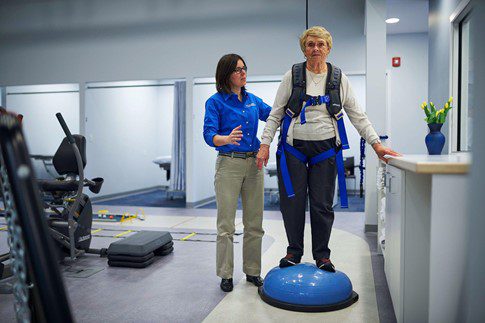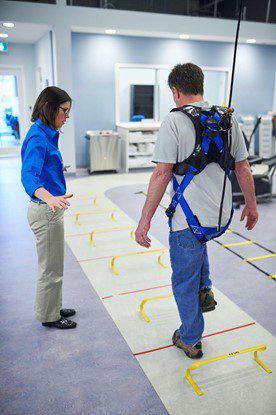
5 Gait Training Exercises to Help Improve Your Mobility
The lack of function and mobility in your lower extremity can be debilitating and impact every part of your life. Fortunately, there are many different ways to alleviate the loss of function and mobility. One way to improve your mobility is by gait training. Gait training refers to learning how to walk, either as a child, or more frequently after sustaining an injury or disability. People who can greatly benefit from gait training include those suffering from:
- Spinal cord injury
- Joint injuries or replacements
- Broken legs or pelvis
- Strokes
- Neurologic disorders such as multiple sclerosis, Parkinson’s disease, and cerebral palsy
- Lower limb amputations or other orthopedic impairments
- Muscular dystrophy, or other musculoskeletal disorders
- Brain injuries
- Sports injuries
- And more
However, anyone can benefit from gait training exercises. It is especially beneficial for elderly people who may be experiencing reduced mobility. Some benefits of gait training exercises are:
- Increased strength in muscles and joints
- Improved balance and posture
- Cardiovascular improvement
- Improved muscle memory
- Decreased risks of falls
- Allows for repetition of movement
- Increased range of motion
- Increased endurance
- Lower risk of illnesses like heart disease and osteoporosis due to physical activity and mobility
Gait Training Exercises
Your gait training program should be specifically suited to your needs. Before starting, you should be confident that your joints are strong enough. Simple stretches every day can help strengthen your joints and muscles. Here are 5 different exercises to help you gain balance and mobility!
-
Single Leg Stance
Single leg stances are an effective exercise to incorporate into your balance training. This simple and basic exercise allows you to improve your balance and decrease the risk of falls.
- Stand behind a steady desk or chair, holding onto the back of it.
- Lift your right foot as you balance your left foot.
- Hold the position for as long as possible, then return to your right foot to standing position.
- Switch to your other foot.
- Repeat 10 times or as many as you are able.
-
Gait Training with Leg Lifts
This exercise strengthens your quads, abs, and hip flexors. Consistently repeating this exercise over time will help you gain strength and walk with greater ease.
- Lay flat on your back with one knee bent and one straight.
- With your toes pointed upward toward the ceiling, raise the straightened leg to be level with the bent knee.
- Return to the starting position and repeat 10 times.
- Switch to your other leg.
-
Sit-and-Stands
This exercise not only improves the leg strength you need for walking, it enables you to get up easier from low chairs or soft couches. Similar to squats, this exercise improves your leg strength, functional balance, and control.
- Seat yourself in a sturdy chair, your feet planted a hip-distance apart.
- Tip forward at the hips, engaging your core. Try to avoid using your hands or arms to assist you.
- Push from all 4 corners of your feet to enable yourself to stand. Extend your knees and hips fully.
- Reverse the movement by pressing your hips back and bending your knees as you slowly lower yourself to a seated position.
- Repeat 10 times or as many as are comfortable for you.
-
Stepping Over Objects
Not all surfaces are smooth, therefore the best practice for this is to step over objects. This will also keep you from shuffling your feet, which can sometimes cause trips and falls. Therapists will sometimes use foam objects spaced a foot or so apart to help you practice your agility while improving balance. If you do this at home, be sure to have a railing or something you can hold onto to keep your balance. This technique has been proven to be especially helpful for those who have suffered damage to the nervous system, as with stroke patients.

-
Walking with a Harness on a Treadmill
Many physical therapy locations use the Solo-Step overhead track and harness system to help patients rehab safely and effectively. The system consists of a ceiling mounted track, a lanyard, and harness to keep patients safe from falls. The Solo-Step track and harness can be placed over many different pieces of equipment, including a treadmill. Utilizing a harness while on a treadmill can give body weight support to help you mimic a normal walking gait. Gradually over time, you can start increasing your walking speed over short distances. The more you walk, the more your muscles will be trained to work for you.
Combining these exercises will most likely provide amazing results! To find a physical therapy location with the Solo-Step overhead track system, please visit https://solostep.com/where-solo-step-is-used/
Difficulties with Gait Training: Talk to Your Doctor
Gait training exercises can be difficult, especially if you are coming out of a very traumatic illness or injury and are relearning how to walk. The process of recovery can take a while, sometimes even longer than we expect. Make sure that every step of the way is guided by a physical therapist or doctor. This will eliminate any potential hazards and roadblocks to your recovery. Health care staff will go over your condition, your gait training plan, and long-term outlook.